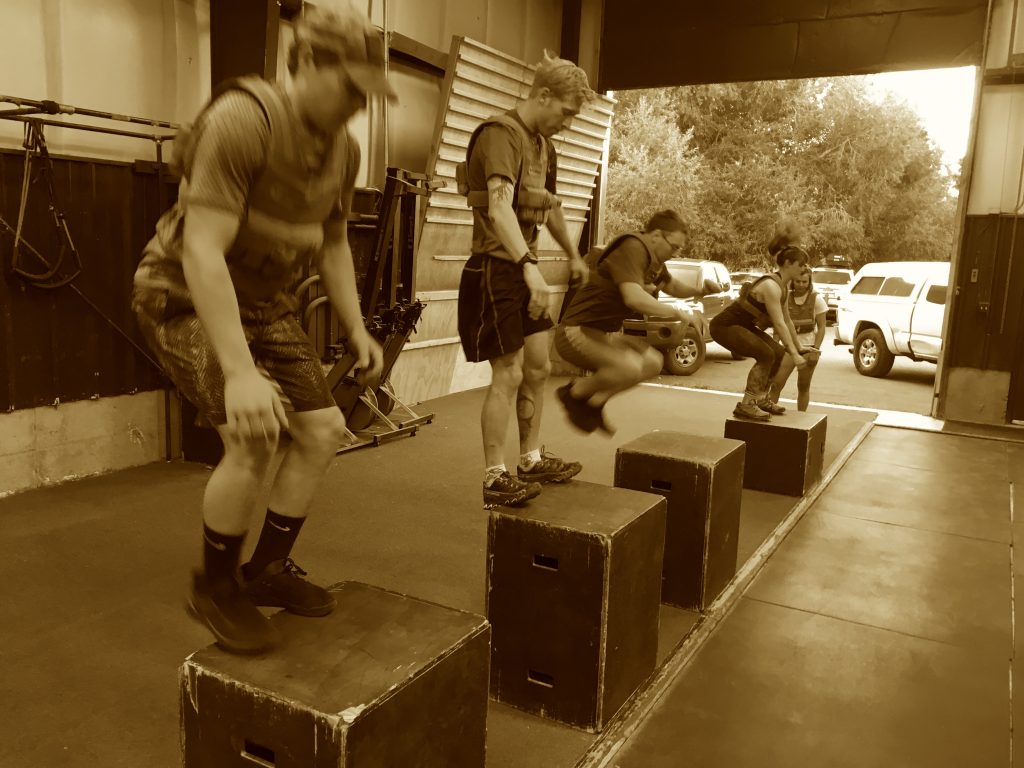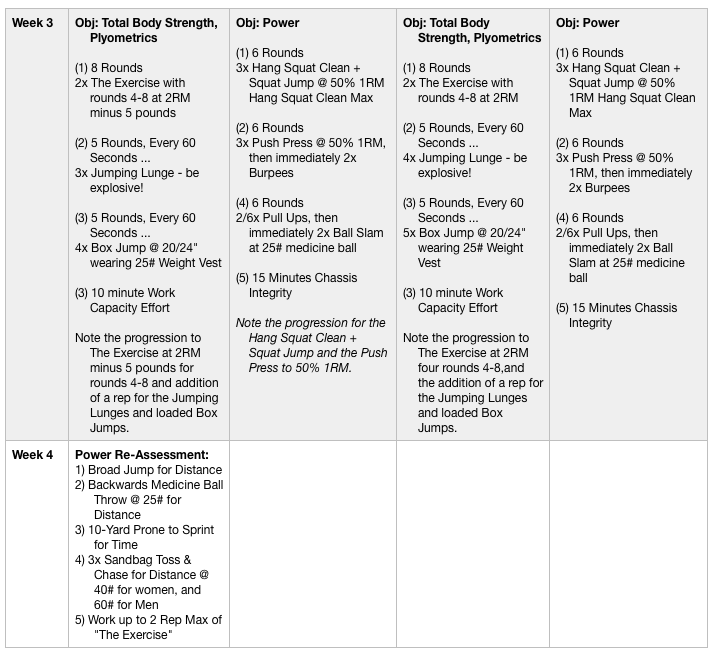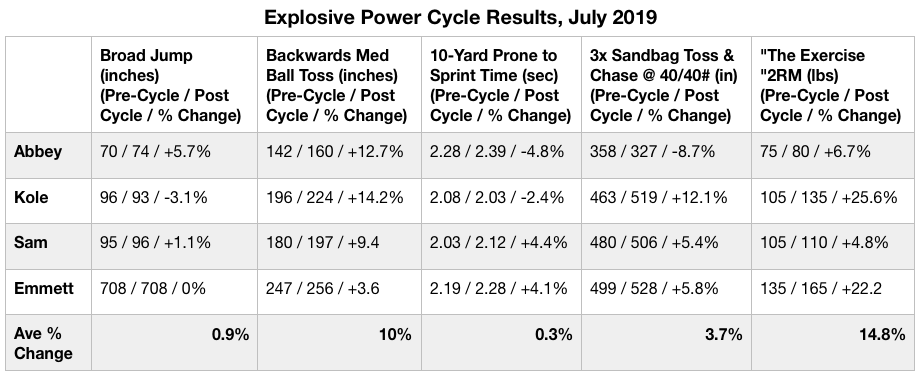
By Rob Shaul, Founder
BLUF
A 3-Week training cycle designed specifically to train explosive power significantly improved assessed performance in just one of the four events assessed. The well-trained subjects in the study improved in the Backwards Medicine Ball toss an average of 10%, but improvement in the other three events, Broad Jump, 10-yard Prone to Sprint time and 3x Sandbag Toss and Chase each saw a 3.7% or less improvement.
Background and Study Design
Training and assessing “explosive power” is much less direct and clear, than doing the same for strength. This cycle sought to develop a battery of four events to assess explosive power, then design a 3-week cycle with exercises and protocols which deployed both common and original exercises and protocols to develop explosive power, and then re-assess at the end of the cycle.
Importantly, the exercises in the cycle were different than the events used to assess explosive power – so the training subjects weren’t training to the test.
In this article, we describe the cycle design in detail.
Below were the events which were used to assess explosive power:
(1) Broad Jump for Distance
Simple assessment, but it could be heavily influenced by athlete familiarity and technique training. For the assessment, each athlete got 1x practice jump, then three official “trials.” The longest trial jump was used as the athlete’s assessment distance.
(2) Backwards Medicine Ball Throw @ 25# Medicine ball
I have my doubts about this assessment, but I’ve seen is deployed by other strength coaches, and now by the Army for the new ACFT and the Air Force for some of their Tier 2 SOF fitness assessments. Like the broad jump, I suspect an athlete’s performance on this assessment could be greatly influenced not by increased “power” but by familiarity with the event and better technique.
(3) 10-yard Prone to Sprint for Time
This is a unique power assessment to MTI which I feel perhaps has the most practical transfer to a tactical athlete. Specifically, the ability to powerfully pop up off the ground from prone and explosively move quickly for a short distance. The practical application of this ability could be quick movement when under fire, or quickly closing the distance on a perpetrator or enemy soldier.
(4) 3x Sandbag Toss & Chase for Distance @ 40# for women, and 60# for Men
I’ve used a similar assessment before in our law enforcement training but narrowed down the event, and tightened up the assessment for this cycle. What I like about the Sandbag Toss & Chase from a power perspective is it involves two total body power movements – first a power clean from the ground to the chest, and next a push press forward for distance. This relatively light loading (60#) for men seems about right – heavy enough to be challenging, but light enough to move explosively.
Exercises and events which were used to train explosive power:
(1) “The Exercise” 2RM and follow on progressions deploying MTI’s “Big 24 Strength” methodology.
I learned “The Exercise” from Strength Coach Dan John which he considered the single greatest movement to train total athletic speed and power. Coach John through his writing, working with CrossFit, and articles on T-nation became fairly well known in the celebrity strength coaching circles. But what many don’t know about his is his incredible success as a high school track coach – esp. with throwers. These field sports (discus, shot put, javelin, etc.) demand demonstration of fast, explosive power and movement.
“The Exercise” combines an Olympic lifting movement (hang squat snatch) and a strength movement (overhead squat). 1x “The Exercise” = Hang Squat Snatch plus an Overhead Squat. It’s an awesome movement and one I programmed into the first Big 24 cycle.
(2) Hang Squat Clean, Push Press at “power” loading and pull ups placed in a “complex” circuit.
The first week of the cycle the subjects each completed a 1RM Hang Squat Clean and 1RM Push Press efforts. Loading at 30%, 40%, and 50%, was deployed in low reps (3) combined with a complex circuit. For example, on Week 1, 3x Hang Squat Cleans @30% 1RM were immediately followed by a squat jump with the barbell. Three Push Presses @ 30% of 1RM were immediately followed by a burpee, and 3 Pull Ups were immediately followed by a ball slam @ 25#.
(3) Unloaded Jumping Lunges
These were progressed from 5 Rounds of 3x each leg every 60 seconds in week 1 to 5 Rounds of 4x each leg every 60 seconds in Week 3.
(4) Box Jumps @ 20/30″ wearing 25# Weight Vest
These were progressed from 5 Rounds of 3x every 60 seconds in week 1 to 5 Rounds of 5x every 60 seconds in Week 3.
Full Cycle Below


Results and Discussion
Below are the pre and post cycle assessment results, and the percent changes. Also included are the results from the pre and post cycle 2RM “The Exercise” effort:

The cycle results were unexpected and somewhat disappointing. We were hoping to see a significant increase in the 10-Yard Prone to Sprint event and the Broad Jump, and not see an improvement in the medicine ball toss. We couldn’t predict what would happen with the sandbag toss and chase exercise.
The 2RM “The Exercise” was not an assessed power event, and we were not surprised by the 14.8% average improvement.
This cycle purposely did not “train to the test” and include the assessment events in the programming. Based on a decade of prior experience, including the assessment events in the cycle programming would have led to more significant gains.
The average improvement in the backwards medicine ball toss was especially surprising, as going in, we considered this the most technique-driven of any of the assessment events, but the subjects did not get to practice between assessments.
The most “mission direct” of all the assessed events was the 10-yard prone to sprint, and we were disappointed in the results, and the negligible 0.3% average improvement. We hoped to see improvement in this event, and be able to link that improvement to “The Exercise” progression, but this didn’t occur.
Strength and Conditioning Lore has it that in 1960, the Russian National Team tested the short distance sprint ability (10m or so) of the teams Olympic Weightlifters, and they performed at or better than the team’s sprinters. While this cycle was not build around Olympic lifting, inclusion of “The Exercise” was for this purpose, but didn’t see the result expected.
Next Steps
One future study would be to use the same events to assess explosive power, but design a cycle which deployed and progressed these same events. While this would very well demonstrate greater improvement in these specific events, we’re not sure this “train to the test” approach would improve mission-direct explosive power.
Questions, Comments, Feedback? Email rob@mtntactical.com
You Might Also Like Mini Study: 4 Weeks of the Barbell Complex Leads to Overall Strength Gains in Well Trained Athletes
STAY UPDATED
Sign-up for our BETA newsletter. Training tips, research updates, videos and articles - and we’ll never sell your info.
